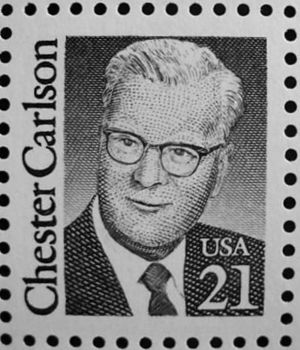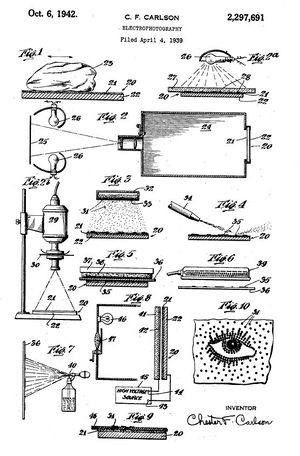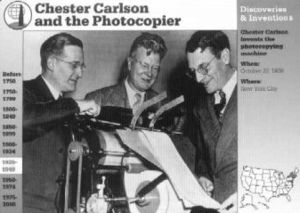- Birthdate
- 1906/02/08
- Birthplace
- Seattle, WA, USA
- Associated organizations
- Haloid Company, Xerox Corporation
- Fields of study
- Xerography
Biography
On 8 February 1906, Chester F Carlson, the inventor of "electron photography," was born in Seattle, Washington. For marketing purposes, the Haloid Company, which had obtained exclusive commercial rights to Carlson's idea, changed the technically apt but otherwise unattractive name of electron photography to the more exotic "xerography." In time, the Haloid Company would rename itself the Xerox Corporation. As a 1962 article in Fortune explained, it was an Ohio State professor of classics who suggested the name of xerography to Haloid's public relations department. In Greek "xero" means "dry" and "graphy" means writing. Carlson's patent on xerography represented a radically new direction in printing technology, perhaps the most dramatic change since Gutenberg's work on movable type in the 15th century. For the first time, all manner of printed material, line drawings and half-tones could be copied easily and quickly onto untreated paper without the use of chemicals. Xerography revolutionized office work around the world and became a source of enormous economic value. Laser printing, invented by an engineer at Xerox, has furthered multiplied the economic potential of the xerographic process. As brilliant as Carlson's patent was, the story of xerography is more a testament to Carlson's great inner strength, which had been forged in the crucible of hardship, than to genius.
Chester Carlson was honored with the printing of a 21 cent stamp, which was issued first on October 21, 1988. He was knows as the "Father of Xerography" (see image to the right).
Early Life
Carlson was born into abject poverty and spent all of his boyhood and early manhood in its tight grip. Homelessness was a constant threat throughout his childhood. By age 12, Carlson had to work to help his parents, and by 14 he had become the family's main breadwinner. In a well-written biography of Carlson, David Owen explains that "[Carlson] was a shy, soft-spoken boy who, deep within himself, couldn't help sharing his parents' deepening despair about the precariousness of their existence." And yet, the young Carlson would not let poverty crush his spirit as it had done to his father. He continued to go to school, while working to support his family, and developed a strong interest in science. With little hope of going to college, the adolescent Carlson was convinced that a career as an inventor was the only way he could use his technical talents to break free of poverty. Stories of successful inventors like Edison had made a strong impression on Carlson. In high school, Carlson started to keep a notebook on ideas for inventions. Though devastated by his mother's death and left to take care of an invalid father, Carlson's desire to learn was too strong not to go to college. Carlson got into Cal Tech and managed to graduate in physics with decent grades, although he had to work to support himself and his father. He regretted going to Cal Tech. Poverty made Carlson feel like an outsider. And yet, in later years, Carlson observed that his rigorous grounding in science and math proved very useful to his work in xerography. The inner strength he summoned to educate himself not only gave him the technical skills to invent a bold idea, but it also prepared him to wage a single-handed battle to pursue an invention that others thought was a useless curiosity.
The Idea of Xerography
The idea of xerography only came to Carlson while he was taking law courses. The Great Depression was not the best time to graduate from college. There was an over abundance of physicists, many of whom had higher degrees than Carlson. He used his technical training to get a job in the Bell Labs patent department, after which he moved on to the patent department of the electrical and electronic manufacturer P.R. Mallory & Company. Carlson then thought it wise to get a law degree. But all during this time, he still harbored a deep desire to invent something great. While copying text from law books that he could not afford to buy, Carlson's inventive desires naturally turned to finding an easy way to duplicate documents. Convinced that photographic techniques using chemicals would not work, he looked for a new angle. His Cal Tech degree would now serve him well. He started to study the work of other physicists in search of a phenomenon that could serve as the basis for a new copying technique. He then came upon photoconductivity which deals with the conductive properties of materials when subjected to light. On 8 September 1938, he filed for a patent on "Electron Photography" and was granted patent # 2,221,776 on 19 November 1940.
In retrospect, one could say that patent #2,221,776 ushered in a revolution in printing technology and stupendous business opportunities. But at the time, no one saw any significance or value in it. Carlson knocked on numerous big corporate doors, including GE, RCA and IBM. The response was an unequivocal "not interested." Sustained only by a quiet, but deep inner strength, Carlson worked in relative obscurity trying to develop a demonstration that photoconductivity and electrostatics could indeed provide a workable framework for copying documents. The early work in xerography did not emerge from the large, well equipped, and sophisticated R&D laboratory. Instead, Carlson toiled away in crude makeshift labs, sometimes using his kitchen, other times a rented backroom.
In 1944, Carlson's hope to commercialize "electron photography" got a boost when the Batelle Memorial Institute and the Haloid Company got involved. But even then it would take another 15 years before the Haloid Company would produce a successful xerographic machine, the 914. Carlson's patent was the crucial first step. But it took a team of talented scientists and engineers and a good deal of money to solve the large number of very difficult technical problems that blocked xerography's successful commercialization. According to Owen, "Carlson's most important contribution to the project during the 1950s was probably helping to maintain the company's enthusiasm for his idea, despite repeated setbacks."
This story has an unexpected twist that deserves special mention. The 19th century development of interchangeable-parts manufacturing in armories, the early work on electronic digital computers, and the aggressive pursuit of miniaturization in electronics are all examples of the important role the peace-time military enterprise has played in underwriting technological development in the United States. And as such, the military also played an important role in xerography. Owen relates the U.S. military's concern that standard reconnaissance using photographic techniques would be nullified, if nuclear weapons were used. The silver halide emulsion in photographic plates is extremely sensitive to background radiation. Nuclear fallout could easily cause silver halide emulsions to fog. In 1948, the Signal Corps, at Fort Monmouth, N.J., gave Batelle and Haloid a considerable amount of money to look at electro-photography as an alternative to conventional photography. Military imperatives thus provided an important source of funding to help underwrite early xerography R&D.
The 914 was an enormous success, and within a few years it catapulted the insignificant Haloid Company to the Xerox Corporation — the fifteenth largest company in the United States. Carlson had become extremely wealthy. The adolescent's dream had come true: a great invention had indeed freed him from poverty. Although wealthy, Carlson lived simply. He preferred to give away his considerable wealth to a variety of social causes. Hardship had not only given Carlson enormous inner strength, it also had opened up his heart to the needs of society.
Further Reading
David Owen, Copies in Seconds (Simon & Schuster, 2004).



